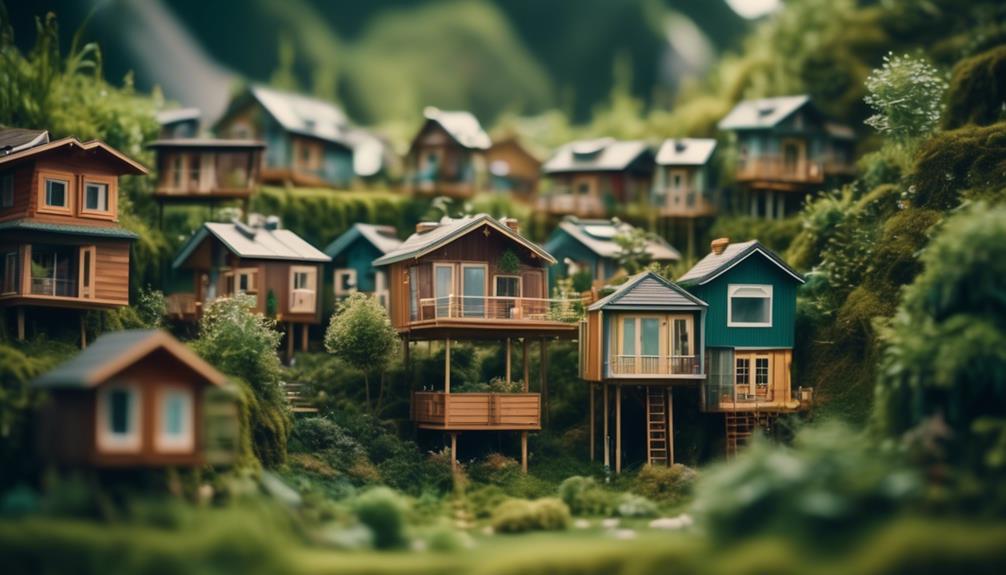The allure of unconventional and charming tiny homes on stilts continues to captivate those seeking alternative living solutions. These elevated structures not only offer a unique aesthetic but also provide practical advantages such as flood protection and the ability to build on challenging terrains.
But the appeal of these tiny homes on stilts goes beyond their functionality. In this discussion, we will explore the fascinating world of these unconventional dwellings, uncovering the secrets of their design, construction, and the inspiring possibilities they hold for those seeking a truly extraordinary living experience.
Get ready to be enchanted by the world of tiny homes on stilts and discover the limitless potential that lies in rising above conventional living.
Key Takeaways
- Tiny homes on stilts provide practical solutions for various challenges, such as protecting beachfront properties from flooding and enabling building on difficult terrain.
- Building a tiny home on stilts requires careful engineering and design, including proper foundation and pier construction, following building codes, and involving an engineer for DIY projects.
- Engaging an engineer is crucial when designing plans for a tiny home on stilts, considering factors like sloped land and solid mounting options, and including details for structural elements.
- There are various design ideas for tiny homes on stilts, including beach house-inspired structures, elevated mountain homes with stunning views, lofted treehouses, modern country-style homes, and monitor-style barns with living quarters.
Benefits of Tiny Homes on Stilts
Tiny homes on stilts offer numerous benefits, making them a practical and versatile housing option for various scenarios.
One of the key sustainability advantages of these homes is their ability to provide protection against flooding in beachfront properties. By elevating the home on stilts, it reduces the risk of damage caused by rising water levels.
Additionally, the ability to easily relocate these homes in case of storms or flooding adds to their sustainability value. This flexibility ensures that the homes can be moved to safer locations, minimizing the need for costly repairs or reconstruction.
Furthermore, tiny homes on stilts can often result in finding affordable land deals, as they can be built on steep or difficult terrain that might not be suitable for traditional housing. This cost effectiveness analysis makes them an attractive option for individuals looking for affordable housing solutions.
How to Build a Tiny Home on Stilts
Building a tiny home on stilts requires meticulous engineering and precise design to ensure a sturdy foundation and structural integrity. Here are some key considerations to keep in mind:
- Stilt foundation design:
- Proper foundation and pier construction are crucial for stability.
- Soil testing should be conducted to determine the appropriate foundation design.
- Engaging an engineer is essential, even for DIY projects.
- Cost considerations:
- Building on stilts can be more expensive than traditional foundations due to the additional materials and labor required.
- However, it can also provide cost savings by allowing for the use of cheaper land in unconventional locations.
- Careful budgeting and planning are necessary to ensure the project stays within your financial means.
Tiny House on Stilts Plans

When embarking on the construction of a tiny home on stilts, careful planning and expert guidance are essential to ensure a solid foundation and successful execution of the project.
Tiny house on stilts plans should consider the unique challenges of sloped land and provide solid mounting options. One important consideration is the use of concrete piers as a foundation, as they provide stability on uneven terrain.
Additionally, the plans should include details for the ledger board and other structural elements, ensuring that the home is securely attached to the stilts.
Engaging an engineer is highly recommended to design plans that meet all necessary requirements and ensure the structural integrity of the tiny home on stilts.
Tiny House on Stilts Terminology
Understanding the terminology associated with tiny homes on stilts is crucial for anyone considering or involved in the construction of these innovative and versatile structures. Here are some key terms to familiarize yourself with:
- Beam construction: Beams are horizontal framing members that support the joists. They play a critical role in distributing the weight of the structure and providing stability.
- Decking materials: Decking refers to the dimensional lumber stock that forms the floor of the deck. Choosing the right decking materials is important for durability and aesthetics.
- Footers: Footers are concrete columns below grade that support the posts. They provide a solid foundation for the structure and help distribute the weight evenly.
Design Ideas for Tiny Homes on Stilts

Designing a tiny home on stilts offers endless possibilities for creating unique and innovative living spaces that blend functionality with breathtaking aesthetics.
One design idea is the lofted treehouse, which allows residents to enjoy a view of their property while feeling nestled among the treetops. This design concept is perfect for those seeking a connection with nature and a sense of tranquility.
Another idea is the modern country tiny home, which combines sleek modern design with a rustic feel. This style incorporates elements such as exposed wood beams, reclaimed materials, and earthy color palettes to create a cozy and inviting space.
Whether you prefer the whimsical charm of a lofted treehouse or the rustic elegance of a modern country design, designing a tiny home on stilts allows you to create a living space that is both functional and visually stunning.
Tips for Living in a Tiny Home on Stilts
Living in a tiny home on stilts offers a unique and elevated living experience, allowing residents to embrace a minimalist lifestyle while enjoying the benefits of being raised above the ground. Here are some tips for maintaining and insulating a tiny home on stilts:
- Regularly inspect the foundation and supports to ensure they are in good condition and free from any signs of damage or wear.
- Use weather-resistant materials for the exterior of the home to protect against moisture and harsh weather conditions.
- Install proper insulation in the walls, floors, and roof to maintain a comfortable indoor temperature and reduce energy consumption.
- Consider using double-pane windows and doors to improve insulation and reduce heat transfer.
- Implement proper ventilation to prevent condensation and moisture buildup.
- Use skirting around the base of the home to provide additional insulation and protect against pests.
Frequently Asked Questions
What Are Some Potential Challenges or Considerations When Building a Tiny Home on Stilts?
Challenges and considerations when building a tiny home on stilts include careful engineering and design, ensuring proper foundation and pier construction, following building codes and inspections, soil testing for foundation development, and the involvement of an engineer for successful execution.
Are There Any Specific Building Codes or Regulations That Need to Be Followed When Constructing a Tiny Home on Stilts?
When constructing a tiny home on stilts, it is important to follow building codes and zoning regulations. For example, in some areas, the height and setback requirements may vary, so it is crucial to research and comply with local regulations to ensure a successful build.
How Do You Determine the Appropriate Height or Number of Stilts Needed for a Tiny Home?
Determining the appropriate height or number of stilts for a tiny home depends on several factors, such as the desired elevation, the terrain, and any local building regulations. Consulting with an engineer or architect is crucial for accurate calculations and adherence to safety standards.
Can a Tiny Home on Stilts Be Built in Any Location, or Are There Certain Areas Where It May Not Be Feasible?
Building a tiny home on stilts can be feasible in many locations, including urban areas, depending on local regulations. However, careful consideration of the environmental impact and structural requirements is necessary to ensure a successful and sustainable project.
Are There Any Special Maintenance or Upkeep Requirements for a Tiny Home on Stilts Compared to a Traditional Home?
Specialized maintenance and upkeep requirements for a tiny home on stilts compared to a traditional home include regular inspections of the foundation and structure, ensuring proper drainage and ventilation, and addressing any potential issues with the stilts or supports.
Conclusion
In conclusion, tiny homes on stilts offer an unconventional and charming living solution. They provide protection against flooding and allow for construction in challenging terrains.
The mobility factor and potential for finding affordable land opportunities make these homes a practical and sustainable choice.
With careful consideration and creative design ideas, living in a tiny home on stilts can be a captivating and unique experience.

